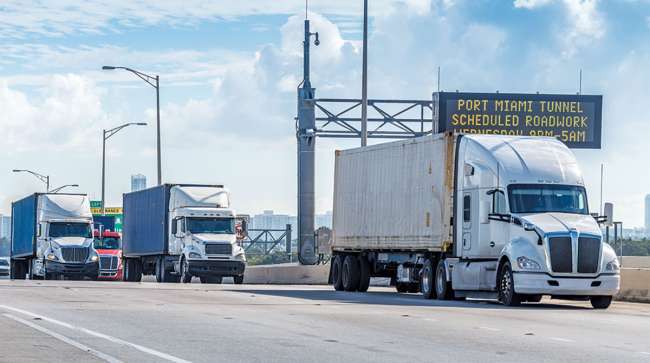Shippers Remain in Control of Rates, but 2023 Could Bring Balance

[Stay on top of transportation news: Get TTNews in your inbox.]
Shippers are in the driver’s seat as spot and contract rates continue to soften, but industry analysts said rates likely will stabilize throughout 2023.
“Shippers have substantially more market power now than they did a year ago, and carriers are more interested in locking in volumes. This means contract rates are going to be going down for at least six months, if not longer,” said Noël Perry, principal at Transport Futures. “This is going to be a lousy year for contract rates, and more so for contract than spot because spot rates have already reacted.”
Tim Denoyer, vice president and senior analyst for ACT Research, said pricing power shifted to shippers throughout 2022 but said there was a slower decline in December, which may be a sign the bottoming process is beginning.

Denoyer
“Recession is a reasonable expectation given monetary conditions, but in the truckload market, we believe the bottoming process is picking up speed, and the loose market current conditions should rebalance over the course of 2023,” he said.
On the contract side, new rates being negotiated by carriers are down 12-16%, said Dean Croke, principal analyst for DAT. “Carriers are rebidding contracts to hold onto the capacity,” he said. “The important thing is that we won’t see the bottom anywhere like we did in 2019, which was a watermark for lower rates.”
David Spencer, director of business intelligence at Arrive Logistics, said spot market woes likely will continue in 2023 as strong routing guide compliance on contract freight drives further demand declines.
There is very little room for spot rates to drop further.
David Spencer, director of business intelligence for Arrive Logistics
Image
“However, spot rates can only fall so far before carriers lose enough money to pull trucks off the road. There is very little room for spot rates to drop further, so we expect they will find a floor in Q1 or Q2 and remain stable as contract rates normalize in the new year,” Spencer said.
Early December linehaul rates illustrated that the spot market responded positively to seasonal and other market trends and contract rates continued to move.

Perry
“The gap between the two closed by $0.11 per mile in December; this is significant, but a large disparity remains and should continue to drive downward pressure on contract rates for the foreseeable future,” Spencer said, adding many shippers are waiting for prices to bottom out before renegotiating.
Changes in contract rates lag spot rates. “Spot rates are instantaneous. It is the price I negotiated yesterday,” Perry said, adding that contract rates are more laborious and tend to last six months or longer. “Contract rates in December were negotiated based on conditions in the spring, not now.”

Croke
The typical lag between spot and contract rates is four to six months, Croke explained. “We saw spot rates turn in April, but it wasn’t until August that we saw contract rates start to trend down,” he said. “They will continue to go down throughout Q1 and into Q2, and then I think you’ll see rates increase at inflationary rates the rest of the year.”
The challenge for carriers is that they’ve experienced increased operating expenses, with equipment, fuel, insurance and driver pay all on the rise. “There is a major profit squeeze here, even if we don’t get a recession,” Perry said.

Roush
David Roush, president of KSM Transport Advisors, said that over the past two years, carriers experienced 30% inflation in their costs. “They can’t do anything about that. In previous cycle changes, the shippers were able to claw back increased rates from the upcycle, and it was more supply and demand,” he said. “What is different this time around is the shippers know they can’t just go for blood and can’t dig down as deep as they might have in the past.”
What’s more, shippers and carriers understand that protecting their relationships and keeping volume relatively stable is good for both of them. “Shippers know there is going to be another up cycle for the carriers and they are going to need those carriers, so they don’t want to gut them,” Roush said.

A flatbed truck hauls construction materials on Interstate 71 in Kentucky. (John Sommers II for Transport Topics)
Several large fleets are now 100% contract. “The freight they take is committed freight. It is committed by the shipper, and the capacity provided by the carrier is committed. If you are 100% dedicated, there is no cyclicality in volumes and capacity, so rates don’t change,” Perry said. “That is a damper among other dampers on contract rates compared to spot rates.”
Some shippers are “channel shifting” and moving to the spot market to take advantage of lower rates, but Roush said he expects more contract negotiations, especially among carriers and shippers with long-term relationships.
Perry anticipates contract rates will drop 3-5% in 2023 but said they could dip 5-8% if there is a recession, which he is forecasting. At the same time, costs will increase 2-3%.
“This will be a difficult year for trucking. There is a squeeze between costs and the market,” he said.

Hosts Seth Clevenger and Mike Freeze mark 100 episodes of RoadSigns, which started off four years ago asking, "Autonomous: Who's Behind the Wheel of Tomorrow?" Now, see where trucking was in 2018 and where it's going in 2023. Hear a snippet, above, and get the full program by going to RoadSigns.TTNews.com.
Spencer said there are conflicting reports about whether 2023 will bring a mild recession, soft landing or no landing. “Each outcome would have different implications, but carriers with contract freight should expect at least some assurance of consistent volume in the event of a mild recession,” he said.
If consumer demand wanes significantly, shippers’ RFP contract volume estimates could come up short and leave carriers with less freight than expected.
“Keeping trucks on the road might become more challenging for those relying primarily on the spot market as freight opportunities remain scarce and equilibrium conditions continue driving rates toward a floor in Q1,” Spencer said.
The propensity of the U.S. economy to generate freight has been slightly negative for the last nine months, Perry said.
“In 2020, after the economy reopened and the government stimulated the economy, the propensity of our economy to generate freight increased by 10%, which is a record. We’ve been running 10% of normal for three years. It is coming back to normal,” Perry said. “The whammy on this particular exposure is that even though the economy is no longer generating increased amounts of freight, it is still generating more than normal amounts of freight on an absolute basis rather than a rate of change basis.”
Last year, shippers were moving a lot of air. “We had the same tonnage … but the velocity of trucks in the network slowed down. It created the illusion we had tight capacity,” Croke said, adding that when fuel prices surged, shippers started to consolidate freight.
Want more news? Listen to today's daily briefing above or go here for more info
At the same time, demand dropped and ports cleared, so velocity increased.
“When velocity increases, capacity increases,” Croke said.
What’s more, the latest capacity numbers out of the Federal Motor Carrier Safety Administration and the Bureau of Labor show that the trucking industry still is adding capacity, Perry said. “The big carriers are still adding tractors and have been ordering tractors like crazy, but for the latest months, orders are down,” he said.
Croke said that the single biggest driver of rates decreasing is the trucks that entered the market last year. “Demand is the same, but you have more supply,” he said.
With rates coming down, Spencer said there is not a clear yes or no answer as to whether carriers will dial back driver wages as they work to control costs.
You can’t go back to your workforce and say we’re going to pay you less.
David Roush, president of KSM Transport Advisors
“Though rates are declining, we don’t anticipate them falling further than the floor reached in the previous cycle,” he said, “which means most pay increases should be sustainable.”
Taking pay back is challenging. “You can’t go back to your workforce and say we’re going to pay you less,” Roush said.
However, Perry said carriers might hold on to pay increases less than they have in the past. Driver pay in 2007 and 2008 was high but returned to below trend in 2008 and 2009. Plus, driver miles change in a downturn.
“In ’08 and ’09, there is evidence drivers gave back what they gained,” he said, noting that U.S. demographics are worse this time. “For the past 30 years at least, the demand for drivers has been greater than the expansion in the workforce.”
Even with the current challenges and a potential recession, Croke said he expects 2023 to be the most normal year of the past three.
“We’re starting to see it in shippers, customers and rates,” he said. “It really feels like seasonality is coming back into the market. It has been missing for three years.”





